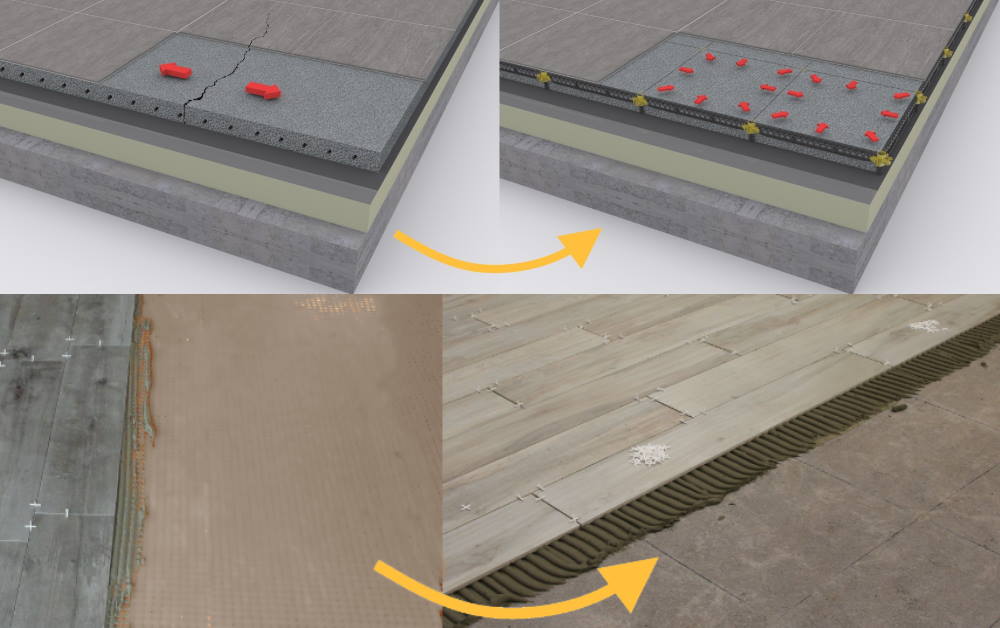Self-build system makes decoupling mat redundant
By Staenis | | Manual
Want to prevent damage to your floor? This DIY system makes an expensive decoupling mat unnecessary.
Many floors show damage over time: cracks, subsidence, and so on. That can be improved. By placing a decoupling mat under your floor finish, stresses in the floor are largely absorbed. But such a mat is not cheap. Discover how to avoid the cost of a decoupling mat and save about 30 euros per square meter, without compromise.
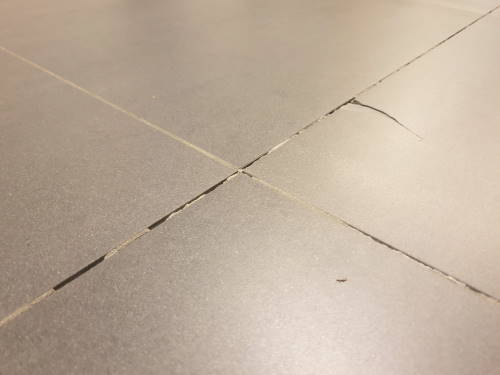
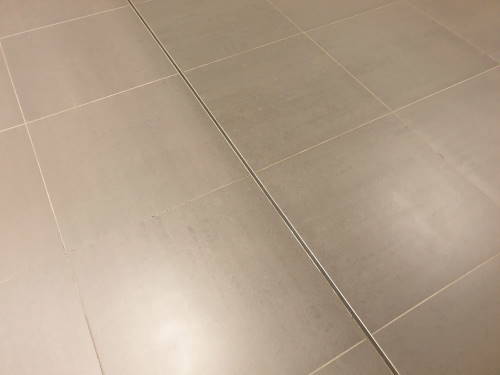
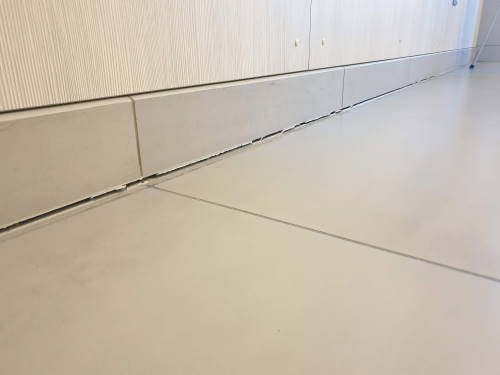
Damage cases involving tiled floors, a common problem
From cracks, subsidence and loose tiles to loose joints and unintended expansion joints. Many tiled floors show damage over time. This not only disrupts the beautiful overall picture, it also leads to unpleasant situations. How does damage occur to tiled floors? The causes of damage to tiled floors are very diverse. The error often occurs during the design and/or preparation phase. The Scientific and Technical Centre for the Construction Industry (WTCB, now Buildwise) emphasises that you must take into account the flatness of the substrate and the level of the finished tiled floor, and that you must provide the necessary reinforcement. How can you prevent damage to your future floor as much as possible? Discover here how to limit the risk of damage.
Preventing damage to floors: how does decoupling help?
Tiles are subjected to varying temperatures due to, for example, sunlight or underfloor heating. When heated, the tiles temporarily expand, which causes stress in the floor finish. As a result, tiles can come loose, crack, or break. This mainly happens where they are glued directly onto the stony substrate. By decoupling, you can largely prevent such damage. Decoupling means that the floor finish can move independently of the substrate. Between the substrate and the tiles, a dimpled plastic foil (decoupling mat) is applied. In this way, the tile can sufficiently expand and contract. Not interested in extra costs? Discover the Staenisrooster and save about 30 euros per square meter.
What is the function of a decoupling mat?
A decoupling mat is a type of decoupling system that is placed between the floor finish (e.g., tiles) and the screed. The decoupling mat is intended to ensure that stresses, movements, and vibrations are not (or only partially) transferred from the screed to the floor tiling. This reduces the risk of cracking in the tiling or the tiling coming loose. By installing a decoupling mat, you do not eliminate the possibility of damage, but you do reduce the risk of damage. However, the StaenisGrid goes one step further. Learn more about the decoupled function of the StaenisGrid.
When should you install a decoupling mat?
Decoupling mats are recommended when the stresses in the floor can become significant. For example, when using large-format tiles, when tiles are installed early, when underfloor heating is used, or when dark tiles are placed outdoors (for example, on the terrace) that are exposed to a lot of sunlight. Specifically, tiles from 60 x 60 are generally installed on a decoupling mat. This also applies to all other tiles that are not installed with straight joints. This advice is based on test trials and damage cases. Do you really need a decoupling mat to absorb stresses in the floor? Not if you lay your screed yourself using a handy DIY system: the Staenis grid.
Want to buy a decoupling mat? You don't need one!
There are various types of uncoupling mats: multilayer uncoupling mats, single-layer uncoupling mats, and drainage mats that are glued to the screed. Expect a cost of about 30 euros per square meter if you hire a professional. Specifically, you pay between 10 and 20 euros/m² for the uncoupling mat, plus the costs of the tile adhesive and the necessary labor hours.
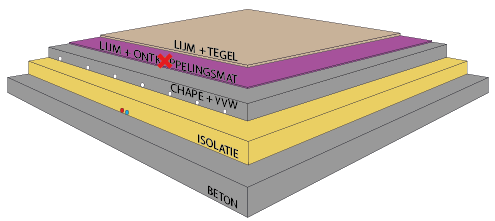
Before you start informing yourself about the ideal thickness of a decoupling mat or consider buying a decoupling mat, you should know that there is another way. Even without a decoupling mat, you can reduce the risk of damage. Get to know an efficient DIY system that makes a decoupling mat unnecessary.
The StaenisGrid makes a decoupling mat unnecessary
As a DIYer, you can easily install your screed or subfloor yourself, even if you have no experience. If you work with the StaenisGrid, you save the cost of a decoupling mat. The StaenisGrid divides the screed into surfaces of 0.5 x 0.5 m. This distributes the dish-shaped effect and the tiles or floor finish experience no stresses. Shrinkage stresses and thermal stresses are also eliminated. With the StaenisGrid, the problem is solved at the source (the screed). As a result, remedies such as a decoupling mat are not necessary. Discover more advantages of the StaenisGrid.
What is most suitable to reduce the risk of damage: a decoupling mat or the Staenis grid?
Decoupling mats absorb horizontal forces and stresses. But the StaenisGrid goes a step further: this DIY system absorbs both horizontal and vertical forces or stresses. Moreover, you no longer need expansion joints on large surfaces. Expansion joints are still placed at door openings. Watch the introduction video and see how the installation of the StaenisGrid works.
If I am going to screed my terrace with the StaenisGrid, do I need a drainage mat?
No. A drainage mat is usually used under a screed if there is already a concrete slab. If moisture gets into the screed, the mat collects this moisture. It also drains the moisture away, for example to a drain. But if you use drainage mortar in the StaenisGrid, you don't need a drainage mat. Drainage mortar even lets water through over its entire height, while a mat only lets about 1 cm of water through. Furthermore, drainage mortar is much cheaper than a drainage mat. Moreover, a mat is made of plastic and can be compressed under high load. So while a mat reduces the compressive strength of the floor structure, with drainage mortar everything remains super strong.
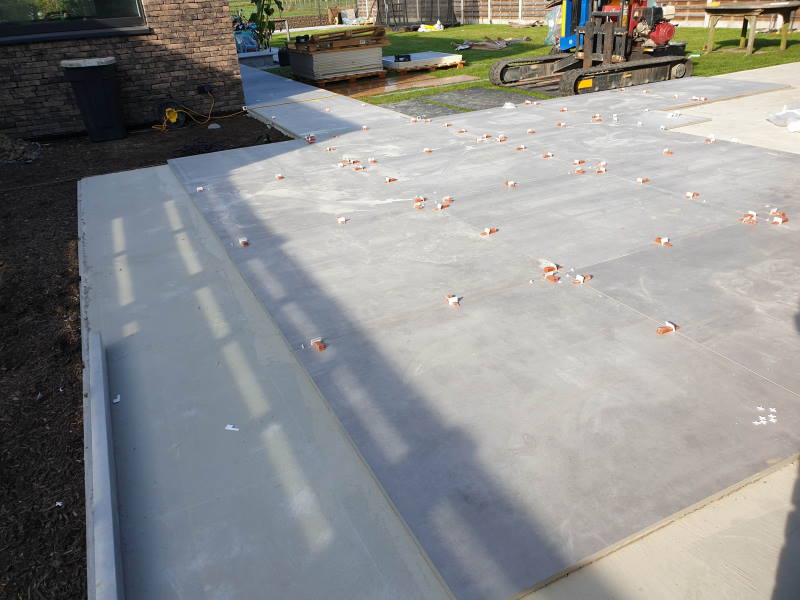
If you want to screed your terrace and there is already a concrete slab present, then a StaenisGrid filled with drainage mortar is ideal for this. You save on a drainage mat and can carry out your project entirely by yourself. This way, you save on material costs and on labor hours from a professional.
Good to know: for a terrace with a flat floor slab, you choose a different floor structure than for a terrace with a sloping floor slab. Discover the ideal screed floor structure for your project here.
Technical advantages of the StaenisGrid with screed
Why hire a screeder when you can install your own flat, crack-free screed floor structure? With the Staenis grid, you are guaranteed to succeed. Moreover, you do not need an expensive decoupling mat or drainage mat. Use the floor structure overview and get more information about your ideal floor structure. You can easily order online in the Staenis webshop.
